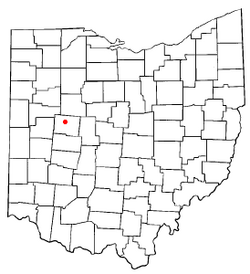Huntsville, Ohio facts for kids
Quick facts for kids
Huntsville, Ohio
|
|
|---|---|
|
Village
|
|

Aerial view of Huntsville
|
|

Location of Huntsville, Ohio
|
|

Detailed map of Huntsville
|
|
| Country | United States |
| State | Ohio |
| County | Logan |
| Township | McArthur |
| Area | |
| • Total | 0.30 sq mi (0.78 km2) |
| • Land | 0.30 sq mi (0.78 km2) |
| • Water | 0.00 sq mi (0.00 km2) |
| Elevation | 1,076 ft (328 m) |
| Population
(2020)
|
|
| • Total | 408 |
| • Density | 1,346.53/sq mi (520.59/km2) |
| Time zone | UTC-5 (Eastern (EST)) |
| • Summer (DST) | UTC-4 (EDT) |
| ZIP code |
43324
|
| Area code(s) | 937, 326 |
| FIPS code | 39-36988 |
| GNIS feature ID | 2398564 |
| Website | https://huntsvilleohio.net/ |
Huntsville is a small village located in Logan County, Ohio, in the United States. In 2020, about 408 people lived there. It's a quiet place with a rich history and important connections to transportation.
Contents
History of Huntsville
Huntsville was first planned out in 1846. This means its streets and lots were officially mapped. The village was named after Aaron L. Hunt, who was a government surveyor. He helped measure and map the land.
The village officially became a town in December 1865. This process is called being "incorporated." It means the village gained its own local government. This allowed it to make its own rules and manage its own services.
Geography of Huntsville
Huntsville is a small village. According to the United States Census Bureau, it covers an area of about 0.30 square miles (0.78 square kilometers). All of this area is land. There are no large bodies of water within the village limits.
People of Huntsville
The number of people living in Huntsville has changed over the years. Here's a look at how the population has grown and shrunk:
| Historical population | |||
|---|---|---|---|
| Census | Pop. | %± | |
| 1850 | 214 | — | |
| 1860 | 281 | 31.3% | |
| 1870 | 322 | 14.6% | |
| 1880 | 420 | 30.4% | |
| 1890 | 500 | 19.0% | |
| 1900 | 408 | −18.4% | |
| 1910 | 328 | −19.6% | |
| 1920 | 339 | 3.4% | |
| 1930 | 398 | 17.4% | |
| 1940 | 353 | −11.3% | |
| 1950 | 408 | 15.6% | |
| 1960 | 511 | 25.2% | |
| 1970 | 475 | −7.0% | |
| 1980 | 489 | 2.9% | |
| 1990 | 343 | −29.9% | |
| 2000 | 454 | 32.4% | |
| 2010 | 431 | −5.1% | |
| 2020 | 408 | −5.3% | |
| U.S. Decennial Census | |||
Huntsville's Population in 2010
In 2010, the village had 431 people living in it. There were 159 households, which are groups of people living together. Most of the people living in Huntsville were White. A small number were African American or from other backgrounds.
Many households had children under 18 living with them. About 60% of households were married couples. The average age of people in Huntsville was about 35.6 years old. About 30% of residents were under 18. This shows that many families with kids live in the village.
Transportation in Huntsville
Huntsville has always been important for travel. It started as a "railroad town." This means railroads played a big part in its early development.
Railroad History
The Toledo and Ohio Central Railway used to run through Huntsville. This railway even had repair shops for its trains in the village. Trains would travel through Huntsville to places like Saint Marys and East Liberty.
Over time, railroads became less common. By the 1960s and 1970s, parts of the railway lines near Huntsville were no longer used. This happened as companies like New York Central and Penn Central faced problems.
Modern Roads and Highways
Even though it's a small village, Huntsville is a meeting point for several important roads. State Route 274 goes right through the village. State Route 117 also ends in Huntsville.
In addition, U.S. Route 33 passes close to the village. Two other state routes, 366 and 368, start just north of Huntsville. These roads make it easy to travel to and from the village.
Notable People from Huntsville
- Lillian Brown: She was an artist, a producer for radio and TV, an educator, and a make-up artist.
- George Russell Davis: He was a well-known judge.
See also
 In Spanish: Huntsville (Ohio) para niños
In Spanish: Huntsville (Ohio) para niños

